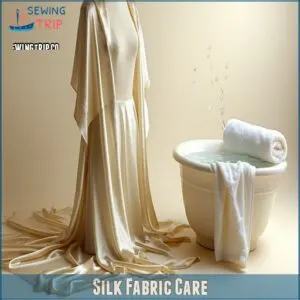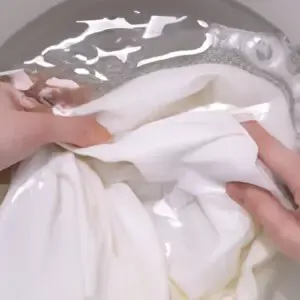This site is supported by our readers. We may earn a commission, at no cost to you, if you purchase through links.
 Caring for different fabrics doesn’t have to be a headache!
Caring for different fabrics doesn’t have to be a headache!
For cotton, stick to cold or warm water to avoid shrinking.
Linen loves cool or warm washes and prefers air drying—fabric softener is a no-go.
Silk and wool are sensitive souls; hand wash them in cold water with gentle detergent and lay them flat to dry.
Synthetics like polyester and fleece do best on gentle cycles with mild detergent, plus low heat or air drying to keep their shape.
Sorting colors and checking labels is key to avoiding laundry mishaps.
Want perfect laundry loads every time? There’s more to discover!
Table Of Contents
Key Takeaways
- Separate your laundry by color and fabric type to prevent color bleeding and damage to delicate fabrics.
- Wash natural fabrics like cotton, linen, silk, and wool with cold or warm water and avoid high heat to prevent shrinkage and fading.
- Use cold water and gentle cycles for delicates and synthetics like polyester and fleece, and skip fabric softeners to maintain their integrity and performance.
- Always check care labels for the proper washing, drying, and ironing methods to extend the life of your fabrics and avoid mishaps.
Natural Fabric Care
Caring for natural fabrics like cotton, linen, silk, and wool takes a little extra know-how to keep them looking their best.
By following the right washing methods, you’ll avoid shrinkage, fading, or damage while enjoying their comfort and durability for longer.
Cotton Washing Instructions
Got cotton? Follow these cotton care tips to avoid shrinkage and keep fabrics soft.
Use warm water for most loads, or cold for colors. A quick machine wash guide: normal cycle, mild detergent, and tumble dry on low.
For stains, tackle them before washing. These fabric washing guide basics guarantee your cotton stays fresh and durable!
Linen Washing Instructions
Linen thrives on gentle care.
Prevent linen shrinkage by sticking to gentle cycles and cool or warm water temperatures—cold for bright colors.
Skip fabric softening; it can dull linen’s charm.
Check laundry instructions to keep it fresh.
For drying methods, line drying works best, but tumble dry low if needed.
This fabric washing guide keeps your delicate fabric care on point, ensuring the preservation of linen’s natural charm.
Silk Washing Instructions
Silk demands respectful care. This delicate fabric thrives with a gentle washing touch.
Stick to cold water and a mild detergent for hand wash clothes. Avoid fabric softener—it’s unnecessary for silk’s natural softness.
Silk stain removal works best by blotting, not rubbing. For Silk Ironing, use a low setting with a cloth barrier.
To maintain silk’s quality, understanding the silk washing guide is essential for its care. Follow this silk washing method for lasting elegance.
Wool Washing Instructions
Treating those woolens right makes all the difference in preventing wool shrinkage.
Use cold water on the gentle wash cycle, or better yet, choose your machine’s dedicated wool cycle.
Skip fabric softening and opt for a specialized wool detergent.
If hand washing, soak for 5 minutes without wringing or squeezing.
Always lay flat to dry, reshaping while damp for fabric shrinkage prevention.
To maintain the quality of wool items, following proper wool care tips is necessary to avoid common mistakes.
Synthetic Fabric Care
While natural fibers need special handling, synthetic fibers have their own quirks regarding fabric care.
Your polyester, fleece, and other synthetic fabrics can last way longer with the right treatment.
Here’s what makes synthetic fiber care different:
- Chemical resistance means you’ll want to skip harsh detergents – they can break down the fabric’s protective coating
- Fabric shrinkage isn’t as big a worry, but high heat can melt or warp synthetic materials
- Fabric softening actually works against you here – it can trap odors and reduce moisture-wicking properties
Keep your synthetic fabrics fresh by sticking to a gentle wash cycle and moderate water temperatures.
You’ll want to dodge fabric softeners and use a laundry detergent specifically made for synthetics.
Most synthetic fabrics do best with a quick tumble dry on low heat or hanging to dry – this helps maintain their shape and performance properties.
Washing Synthetic Fabrics
You’ll find that synthetic fabrics like polyester and fleece need special attention to maintain their quality and performance features.
While these man-made materials are generally more durable than natural fibers, you’ll want to follow specific washing instructions to prevent damage from high heat and harsh chemicals, especially to maintain their performance features.
Polyester Washing Instructions
Anyone can master polyester washing instructions by following a few key steps.
Set your fabric washing temperature to 40°C and choose a normal washing cycle that won’t cause fabric damage.
While you can use any detergent choice, stick to mild options without bleach for best results.
You’ll find polyester dries quickly when hung up, saving energy costs.
Check care label instructions to prevent polyester shrinkage.
For ideal results, follow the polyester care tips to maintain your clothes’ quality and longevity.
Fleece Washing Instructions
Consistently washing your fleece with care keeps its cozy texture intact for years.
Cold water washing on the gentle cycle preserves the fabric’s quality, while skipping fabric softener maintains its insulating properties .
Here’s what your fleece needs to stay in top shape: Proper polar fleece care is essential for extending its lifespan.
- Turn garments inside-out to prevent pilling and preserve softness
- Skip harsh detergents—your fleece craves gentle cleaning
- Choose low-heat drying to avoid fleece shrinkage
- Air-dry when possible for maximum longevity
Rayon Washing Instructions
Rayon fabric needs a gentle touch in the laundry room.
Check your care label first – it’s your fabric type guide to success.
You’ll want to wash rayon in cold water using your machine’s gentle cycle with mild detergent.
Skip the fabric softener to keep your delicate fabrics looking fresh.
When drying, resist the urge to wring – pat dry with a clean towel and lay flat to ensure the longevity of your delicate fabrics.
Acrylic Washing Instructions
While synthetic fabrics each need special attention, acrylic fabric care comes with its own simple rules.
You’ll keep your acrylic clothes looking fresh by following these key steps:
- Set your washer to a low-spin cycle with cool water to protect the fibers
- Skip the high heat – it’s your acrylic’s worst enemy
- Use mild detergent and reshape while damp for best results
Remember to check your care label before washing.
Delicate Fabric Care
You’ll find that your delicate garments like silk and wool need special attention to maintain their luxurious feel and prevent damage during washing.
When you handle these fabrics with care using the right techniques, you’re not just cleaning them – you’re protecting your investment and ensuring they’ll stay beautiful for years to come, which is essentially protecting your investment.
Hand Washing Silk
When caring for delicate silk garments, you’ll want to handle them with extra care to maintain their luxurious feel.
Always check the care label first and test for colorfastness in a hidden spot.
For further detailed instructions, see this helpful silk sheet washing guide.
Here’s what you need to know:
| Step | Silk Fabric Care Instructions |
|---|---|
| 1 | Fill basin with cold water |
| 2 | Add gentle silk detergent |
| 3 | Soak for 3-5 minutes |
| 4 | Rinse without wringing |
| 5 | Air dry in shade |
Tackle stains by gently dabbing with a silk-specific cleaner, avoiding harsh rubbing that could damage fibers.
Hand Washing Wool
When your wool sweater needs cleaning, turn it inside out and submerge it in cold water to prevent wool shrinkage.
Mix a capful of gentle soap with the water, avoiding harsh detergents that can damage wool fibers.
Let it soak for 10 minutes, then rinse twice in clean, cold water.
Gently squeeze out excess water—don’t wring or twist—and lay flat to dry away from direct sunlight.
Gentle Cycle Instructions
In the context of delicate care, your gentle cycle is like a soft embrace for fragile fabrics.
Select cold water and add a mild laundry detergent to start your fabric protection journey.
Your washing machine’s cycle settings should run at 400-800 rpm for soft washing.
Check washing symbols meaning before starting, and remember – gentle washing means shorter spin times and lower agitation for ideal fabric care.
Regarding delicate care, this detail is key to the longevity of your fabrics.
Fabric Specific Care
You’ll find that each fabric type needs its own special washing routine to maintain its quality and extend its life.
Whether you’re handling delicate silk or durable cotton, understanding the right care methods will help you avoid common laundry mishaps and keep your clothes looking fresh.
Cotton Fabric Care
While delicate fabrics need special attention, cotton’s durability makes it more forgiving.
You’ll want to check the thread count – higher numbers mean better quality that’ll last longer.
For ideal cotton durability and fabric softening, use a mild laundry detergent in cold or warm water.
- Your favorite cotton t-shirt deserves to stay soft and cozy through countless washes
- Those perfect-fitting cotton jeans shouldn’t lose their shape
- Keep your cotton blends looking fresh without mysterious shrinkage surprises
Linen Fabric Care
While cotton’s your everyday hero, linen’s the refined cousin that needs special handling.
Your linen pieces last longer with gentle washing in cold water, skip fabric softening – it can weaken the fibers.
To dodge linen shrinkage, air dry flat or use low heat.
When ironing’s needed, spritz with water while the fabric’s slightly damp and press on medium-high for that crisp, polished look.
Silk Fabric Care
From the most lustrous of fabrics, silk demands special attention to maintain its sheen.
You’ll want to treat your silk garments with extra care to avoid damage and preserve their elegant appearance.
- Hand wash in cold water with gentle silk-specific detergents
- Never wring or twist silk – gently squeeze out excess water
- Roll in a clean white towel to absorb moisture
- Air dry away from direct sunlight to prevent fading
When dealing with silk stains, tackle them immediately using specialized silk cleaning products to guarantee the best results.
For storage, keep silk pieces in breathable garment bags, away from harsh light.
Wool Fabric Care
Your wool garments need special attention to stay cozy and pristine .
Always use cold water and a mild wool detergent to prevent wool shrinkage during laundry.
Skip traditional fabric softening products – they’ll damage the fibers.
For effective stain removal methods, treat spots immediately with specialized wool cleaning tips.
When drying, lay your wool flat to maintain its shape, avoiding direct heat or agitation, and remember to handle your wool garments with care to keep them pristine and in good condition, which will help them stay cozy.
Synthetic Fabric Types
You’ll find synthetic fabrics like polyester, fleece, rayon, and acrylic in many of your favorite clothes, since they’re engineered to resist wrinkles and maintain their shape better than natural materials.
While these fabrics don’t come from nature like cotton or wool, they’re created through chemical processes that give them special properties you’ll love, such as quick-drying capabilities and durability.
What is Polyester
Your wardrobe warrior, polyester stands as a triumph of textile science.
Through chemical processes, petroleum transforms into durable polyester fibers that create synthetic materials perfect for everyday wear.
These fabric blends offer wrinkle resistance and strength at a budget-friendly price.
While it’s not the most breathable option, you’ll appreciate how this synthetic fabric handles moisture and maintains its shape through countless laundry cycles.
What is Fleece
Fleece, a soft synthetic fabric, was first designed as a lightweight, warm alternative to wool.
Made from polyester, fleece benefits include excellent insulation and quick drying, making it ideal for jackets and blankets.
Its types range from microfleece to sherpa.
For maintenance, follow these laundry tips: wash on a gentle cycle, cold water, and skip fabric softener—fleece stays cozy longer.
What is Rayon
Rayon is a versatile synthetic material often blended with natural fabrics.
Known for its silky feel and lightweight nature, it mimics luxury without breaking the bank.
Fabric care for rayon? Follow these tips:
- Hand wash or use the delicate cycle with cold water.
- Avoid fabric softeners and harsh detergents.
- Air dry to prevent damage and maintain shape.
The key to maintaining rayon’s quality lies in proper care, ensuring it retains its luxury appeal over time.
What is Acrylic
Acrylic, a popular synthetic fabric, is lightweight, soft, and perfect for knit fabrics.
Known for its wool-like feel, it’s often used in sweaters and blankets.
Acrylic benefits include durability and resistance to wrinkles or shrinking.
Created through advanced textile science, this versatile yarn type requires careful fabric care—wash on a low-spin cycle, cool water, and avoid fabric softeners for lasting softness.
Laundry Detergent Choices
Choosing the right laundry detergent keeps your clothes looking great and feeling fresh. From mild formulas to color-safe options, each type works best for specific fabrics and washing needs.
Mild Detergent Options
In the context of fabric care, choosing the right detergent matters.
Try detergent recommendations like Tide Free & Gentle or Seventh Generation Free & Clear for a gentle wash.
These eco-friendly cleaning products work well on the gentle cycle and preserve clothes.
Soap alternatives like Molly’s Suds can also offer cotton care tips for maintaining softness without harsh chemicals.
For sensitive skin, using a gentle laundry detergent is essential to prevent irritation and allergic reactions.
Sensitive Skin Detergents
Sensitive skin needs extra care when choosing laundry detergent.
Look for hypoallergenic options with gentle formulas that are dermatologist approved.
Fragrance-free detergents are best to avoid irritation.
Using hypoallergenic detergent can substantially reduce skin reactions.
Here are a few tips:
- Use detergents labeled "sensitive skin" for added peace of mind.
- Wash fabrics thoroughly to remove residue.
- Skip fabric softener, which often triggers skin reactions.
Color Safe Detergents
Color safe detergents keep your vibrant clothes from turning dull.
They’re designed for color protection, dye fixing, and fabric preservation without harsh bleach.
Use these for stain removal or fading concerns.
Below’s a quick guide:
| Feature | Benefit |
|---|---|
| Bleach Alternatives | Gentle on colors |
| Colorfastness Boost | Prevents dye bleeding |
| Detergent Recommendations | Keeps colors vivid |
Color Sorting Tips
Sorting your laundry by color isn’t just about avoiding pink socks—it’s the key to keeping your clothes looking their best.
Separating whites, lights, and darks helps prevent colors from bleeding and protects your fabrics.
Washing Whites
Whites Maintenance starts with keeping them separate – no sneaky dark socks allowed.
Washing whites solo prevents color bleeding and helps Fabric Brightening.
Use warm water, a laundry sanitizer, and detergents like Tide Plus Bleach Alternative for Stain Removal and Color Preservation.
Tossing whites together keeps them crisp and avoids dinginess, saving your white laundry from turning fifty shades of gray!
Washing Light Colors
When tackling light-colored clothing, like pastel t-shirts or delicate whites with prints, always pair similar shades to avoid fabric bleeding.
Light stains can set quickly, so pre-treat them before washing.
Use cold water and gentle detergent for color protection.
Sorting light-colored laundry prevents accidental color transference from darker items, keeping your clothes fresh and your laundry game strong!
Washing Dark Colors
When washing dark colored clothing, always separate them to avoid dye run removal headaches.
Use cold water and a gentle detergent for better Dark Color Preservation and to stop Fabric Fading.
Black Clothing Care means pulling items out of the dryer early—static’s no one’s friend.
For Color Protection Tips, toss in a vinegar rinse to curb color transference.
Special Fabric Care
Caring for special fabrics like bamboo, nylon, and spandex requires extra attention to maintain their unique qualities.
By following simple steps suited to each fabric, you can keep your favorite pieces looking and feeling their best.
Bamboo Fabric Care
For bamboo textile lovers, eco-friendly care is easy!
Use cold water, a gentle cycle, and mild detergent to protect fabric softness.
Skip bleach and softeners—they’re bamboo’s kryptonite.
Air-dry to maintain bamboo durability, or go low heat if you must.
Wrinkles? No stress!
A low-heat iron works wonders, and remember to Treat bamboo like royalty, and it’ll last longer.
Nylon Fabric Care
Caring for nylon isn’t tricky, but it does need attention.
To keep nylon threads strong and prevent nylon shrinking, use cold or warm water on a gentle cycle.
Always check care labels for the best advice, and skip fabric softener to maintain fabric softness and durability.
Air dry or use low heat in your washing machine for lasting results, following proper fabric care tips is essential to extend the life of your nylon garments.
Spandex Fabric Care
Keeping spandex stretchy and resilient starts with gentle care.
Use cold water and a gentle cycle in your washing machine to keep fabric elasticity intact and avoid spandex shrinkage.
Air drying is your best bet for stretch recovery, but if you must use the dryer, stick to low heat.
Always check care labels—they’re the secret weapon for perfect spandex fabric care!
Efficient Laundry Tips
You can make laundry day easier by sorting clothes properly, using the right detergents, and following a few simple tricks to avoid common mishaps.
With a little planning, you’ll save time, prevent color bleeding, and keep your fabrics looking their best.
Saving Time on Laundry
Streamline your laundry routine with simple hacks.
Efficient sorting by fabric types saves loads of time, toss items into color-coded hampers right away.
Use the washing machine’s delay start for overnight runs.
Master quick folding by tackling smaller piles.
A Fast Cleaning tip? Treat stains immediately instead of letting them set.
These tricks turn chaos into calm!
Preventing Color Transfer
Sorting your laundry isn’t just a chore—it’s color insurance! For Color Protection, separate light-colored clothing from darks, and always test for colorfastness on new items to avoid Fabric Bleeding.
Tossing in Color Catcher Sheets? They help, but sorting wins. Quick tip? Wash reds with reds—nobody loves surprise pinks!
| Problem | Solution | Result |
|---|---|---|
| Color Fading | Cold water washes | Fresh hues longer |
| Dye Fixing | Test with warm water | Stops color bleeding |
| Stain Prevention | Remove stains early | Saves your favorite tee |
Freshening Up Laundry
Sometimes fabrics just need a quick pick-me-up.
Use fabric softeners for added freshness or try laundry refreshers like vinegar to tackle odors.
Pre-treat stains with a dab of detergent for effective stain removal.
Laundry sanitizers can help with odor control on tougher loads.
Proper laundry sorting, especially washing darks separately, keeps colors vibrant while ensuring freshness lasts.
For ideal results, consider using a laundry refresher to keep your clothes smelling fresh.
Frequently Asked Questions (FAQs)
How do you wash different types of fabric?
Ever notice clothes coming out worse than they went in?
Different fabrics need special care—cotton loves warm water, silk prefers handwashing, and polyester thrives on gentle cycles.
Check labels; they’re like a fabric’s survival guide.
What fabrics should you not wash together?
Don’t mix whites with darks—dark fabrics can bleed and ruin lighter ones.
Avoid washing delicate items like silk or wool with heavier fabrics like denim to prevent damage.
Separate by color and fabric type!
How to wash different types of clothes in a washing machine?
Wash delicates like silk and wool on the gentle cycle with cold water.
Use warm water for cotton, polyester, and linens.
Separate colors, avoid fabric softener for synthetics, and air dry whenever possible.
What temperature should I wash different fabrics?
Did you know over 90% of laundry mishaps happen from wrong temperature settings?
Use cold for darks and delicates, warm for cottons and synthetics, and hot for whites and heavily soiled items.
Easy, right?
How to remove tough stains from fabrics?
Tackle tough stains by acting fast.
Dab—not rub—with cold water, use gentle detergent or white vinegar, and try a stain-specific remover.
For stubborn spots, soak overnight.
Always check the fabric’s label before diving in!
Can you wash mixed fabric blends together?
Throwing all fabric blends together is like serving soup without tasting it first—risky.
Check care labels to verify similar washing needs.
Wash blends with compatible care instructions; otherwise, colors and textures could clash like mismatched socks.
How to prevent shrinkage during washing?
Stick to cold water, gentle cycles, and air drying to dodge shrinkage.
Hot water and high heat act like a recipe for disaster, shrinking fibers fast.
Always check labels—they’re your secret weapon against laundry mishaps!
What fabrics are safe for high heat drying?
Imagine cookies baking too hot—crispy mistakes happen.
Similarly, only cotton, linen, and denim safely handle high-heat drying.
But double-check care labels; even these tough fabrics need guidance to avoid turning wearable favorites into shrunken disasters.
How to maintain waterproof fabric coatings?
Keep waterproof coatings intact by hand-washing with mild detergent, avoiding harsh chemicals, and air-drying.
Skip the dryer.
Restore water-repellency with a spray or heat treatment as recommended, keeping your gear ready for the elements.
Conclusion
Think of laundry care like cooking; using the right “ingredients” keeps it flawless.
Knowing washing instructions for different fabrics guarantees durability and freshness.
Treat cotton and linen with care to avoid shrinkage, while silk and wool need gentler handling.
For synthetics, stick to mild detergent and low heat.
Sort colors and choose detergents wisely to prevent fading or damage.
When you give each fabric the right attention, your clothes last longer, and every load looks its best!
- https://poundfabrics.co.uk/blogs/sewing-resources/washing-instructions-for-different-types-of-fabric
- https://kokkafabrics.com/blogs/resources/the-ultimate-fabric-care-guide-how-to-clean-every-type-of-fabric
- https://www.armandhammer.com/articles/fabric-guide-for-how-to-wash-different-fabrics
- https://automaticlaundry.com/different-fabrics-means-different-washing-methods/
- https://blog.laundryheap.com/laundry-tips-for-different-fabric-types/





















